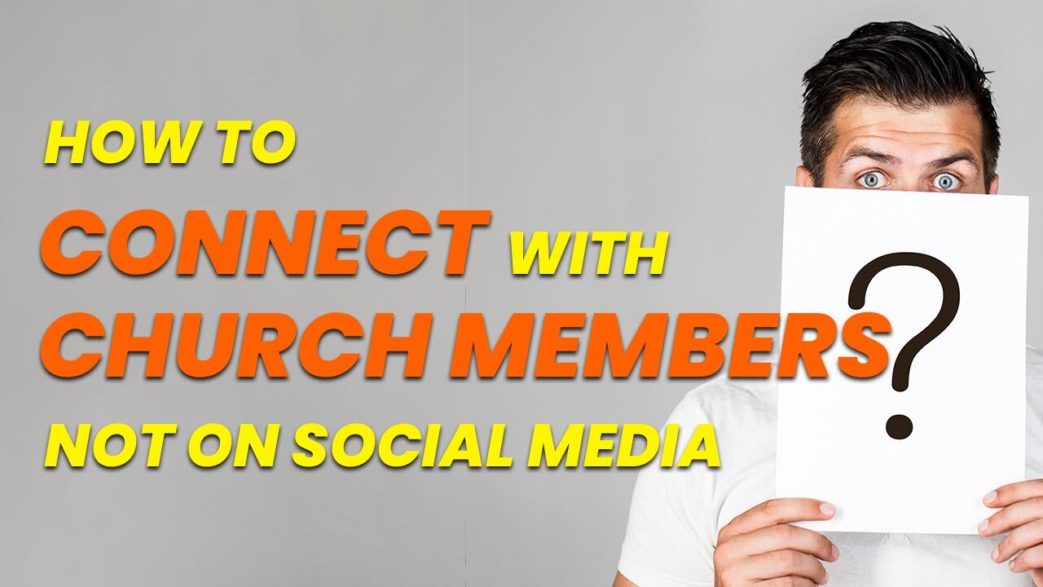Estimated reading time: 10 minutes
If you read about ways to connect with church members, one of the first suggestions is inevitably social media. Yes, it’s effective, but only if your members are using a social network.
Despite the millions of people who do, millions still don’t for a wide variety of reasons. The last thing you want to do is alienate people who aren’t comfortable posting updates on Facebook.
By using a variety of alternative connection options, you’re able to reach all your members, even those who prefer not keeping up with the latest Instagram trends.
Table of contents
- Use Church Newsletters
- Offer Daily Emails
- Implement Text Messaging
- Host Regular Video Chats
- Host Regular Online Chats
- Create A Forum Or Message Board On Your Church Website
- Encourage Conversations On Blog Posts
- Have Weekly In-Person Meetups
- Setup Member Partnerships
- Keep Your Church Website Active
- Upload Videos To YouTube Or Your Website
- Create A Regular Church Podcast
- Offer Tech Training For Those Who Need It
- Try Alternatives To Mainstream Social Media
- For Further Reading

Use Church Newsletters
One of the simplest ways to connect with church members without social media is through church newsletters. Email is still relevant and even many seniors use email to talk with family and get pictures of grandkids. Many churches not only send out the newsletter by email, but offer let people view it on their church website. Of course, you’re free to link to it on social media for those who aren’t subscribed via email.
Sending out a mid-week church newsletter allows you to reach out to members and give them inspirational stories, updates on church happenings, suggested reading and a reminder to call, email, text or visit anytime they need someone to talk to. With so many people still feeling isolated thanks to COVID, adding a phone number and email address people can reach out to is a great idea.
Since it’s a good idea to have a church newsletter anyway, why not make it more personal and use it as an engagement strategy? Depending on the type of content your members like, you might even consider sending two newsletters each week. One could focus more around church announcements while the other might be more about sharing interesting stories, offering a devotional, linking to a blog post diving more in-depth on the weekly sermon and so on.
If you’re not sure where to start with a church newsletter, don’t worry. We’ve created several great guides to help you out:
- Best Church Newsletter Platforms
- How To Design A Great Church Newsletter
- 17 Tips For Creating A Must-Read Church Newsletter
Offer Daily Emails
Some members might get annoyed with this one, but it’s a great way to connect with church members who want the extra emails. The idea is to offer the option to sign up for special daily emails in addition to your weekly or twice weekly newsletter.
Your daily emails offer a deeper way to connect by encouraging members to interact daily with your church. Send out daily devotionals to help start a member’s day off right. If you want to make things even more personal, ask members what topics or issues they’re struggling with and customize the daily emails based on specific themes, such as financial problems or health issues.
You might consider sending out a daily inspirational story. It could be Christian-related or just a feel-good type of story that makes people happier. There are a variety of good news sources that leave out the stress, drama and negativity for something more uplifting.

Implement Text Messaging
Often, text messaging is overlooked with it comes to staying in touch with church members. However, most everyone in your church probably has a phone that supports texting. They don’t need the latest iPhone or Samsung Galaxy to participate. Seniors are often eligible for extremely low cost devices and plans too, making texting an attractive alternative to social media.
As long as members have unlimited texting plans, there are several ways to make the most of this to connect with church members. First, use texts to send out a daily devotional or suggested reading.
Another option is to recruit some volunteers to have daily chats with members who want to participate. These could be 10 to 15 minute text conversations to just check in and help build stronger relationships among members.
You could also send out church announcements. However, don’t bombard people with announcements. An initial announcement followed by a reminder a day before an event is usually sufficient.
Finally, set up texting groups. Members text each other during a set time frame each day to check in. Anyone who wants to participate gets added to a group text. It’s a fun way to get to know each other better and ensure people are staying connected.
Host Regular Video Chats
Throughout 2020, more people than ever were introduced to video chats. From video conferencing to simpler one on one apps, millions used video chat to stay connected. You can do the same thing with your church members.
Obviously, this one is more limited than other options as members will need high-speed Internet or unlimited mobile data plans for this to work. However, for those who can participate, it’s a great option. As a workaround, ask members who do have high-speed Internet to pick up members without it so they can participate in church video chats.
Once or twice a week, hold a video chat with your members. You can host a mini-sermon, a Q&A session, talk about issues members have brought up or anything else. Allow members to ask questions or comments throughout. It might seem simple, but video is a good way to make chatting online seem much more personal.
Host Regular Online Chats
For those who don’t have high-speed Internet or have limited plans, host regular online chats. You can use any free chat app you want. If you’re already hosting video chats, you might consider something like Skype since it offers both video and standard chat.
While apps like Facebook Messenger are popular, members who don’t like social media won’t want to use it. It’s often listed as one of the top apps, but there are a variety of others to choose from. You could even create a special church app just for this purpose.
As long as you can connect with church members regularly, use whatever platform works best. Ask your members to vote on which platform they prefer to ensure you’re choosing something everyone wants to use.

Create A Forum Or Message Board On Your Church Website
It might sound like an extremely old school option, but often members who don’t want to use social media aren’t into downloading apps or learning new software either. Make it easier by putting everything on your church website.
Create a forum or message board for members to interact anytime they want. You might post daily questions to get the conversation started. You could even suggest daily challenges, such as “help a stranger today” or “write a haiku about last week’s sermon.” Then, members can post challenge results and share what they’ve been up to.
Ideally, you’ll want to require members to create a free account to use the forum or message board. This helps keep out spammers. Have a volunteer or two on-hand to verify accounts and only approve actual members. You could also provide a code to members that they’ll enter to give them access. Hand this out in person.
For your online church community, you might want to stick with social media. If volunteer moderators notice regular participants that aren’t causing issues, you can invite them to join your website’s forum.
Encourage Conversations On Blog Posts
Never underestimate the power of a great blog post to help connect with church members. It’s likely something you’re already doing. However, end every blog post with a question to encourage interactions. You’ll want to recruit volunteer moderators to keep the comments clear of spam and inappropriate comments.
Upload at least one or two posts per week. Take time to create a blog strategy that works well for your church. Pay attention to the types of posts that get the most engagement.
Try varying the types of posts you upload too to give members more variety. The most important thing is to upload content that’s engaging, useful and high quality. Do this and you’ll definitely connect well with your members.
Have Weekly In-Person Meetups
So far, everything’s involved technology. But, in-person meetups are still a classic and highly effective way to connect with church members. For example, you might have a weekly luncheon at the church or reserve a party room at a local restaurant. Maybe you can meet in a local park on nice days.
Some churches have hobby groups, such as getting together to play board and card games. Or, they ask volunteers to help teach classes, such as knitting or playing an instrument.
Meetups don’t have to be strictly about church. Instead, they’re more about connection and bringing your church members closer together. Encourage community members to attend as well, even if they don’t attend your church. This is a great way to get new people interested in church and help your church members connect with more people.
You can even host small events. Your church might host weekly or monthly singing in the park. Or, you might have open volunteer sessions where anyone who wants to come is welcome without previously signing up.

Setup Member Partnerships
Sometimes, members just don’t know how to connect with others. They’re shy and trying to get to know everyone is overwhelming.
Offer a less intimidating option. Setup member partnerships. This involves volunteers who are assigned a few other members to text, call and even go do things together. This is great for helping new members connect and feel like part of the church family. It also works well for older members who might feel lonely and want to have a more active social life.
Keep Your Church Website Active
As simple as it sounds, simply maintaining an active church website is often enough to connect with church members without social media. This involves keeping your Events page updated, blogging regularly, adding online prayer and ensuring your site works as intended. If people are trying to connect, but nothing works right, they’ll get frustrated and leave.
If it’s been a while since you’ve updated the look and feel of your site, consider giving it a more modern makeover. This helps make your site more attractive to keep members on it longer.
If you’re encouraging blog comments, make sure you’re responding to them. This helps boost conversations.
Upload Videos To YouTube Or Your Website
Due to schedules, it’s not always possible for everyone to participate in live video chats. Instead, upload videos to YouTube or host them on your church’s website. While YouTube is technically a social media network, no one has to create an account to use it, unless they’re viewing age-restricted content.
Since your church isn’t uploading anything like that, members don’t need to sign up to view your videos. For members concerned with online privacy, this is a bonus.
Creating engaging church videos helps people feel more connected with the church throughout the week. Plus, it can help drive more traffic to your church website, increase new church visitors and help grow your church overall.
Create A Regular Church Podcast
Along with videos, you might consider creating a church podcast. You can have a podcast with or without video. For members who’d rather listen than watch, a podcast is a great option. You can also turn podcasts into blog posts.
Each week, consider interviewing a member, volunteer, someone in the community or a Christian leader. Provide a way for members to submit questions in advance. This encourages them to listen to see what the answer will be.
Offer Tech Training For Those Who Need It
This might not seem like a way to connect with church members, but consider the fact that many of your members might not know how to use technology. They might not have any idea how to download or use an app. The idea of using a laptop or tablet might feel overwhelming and impossible. Younger members have grown up around all this, but older members haven’t.
Provide free tech training to anyone who wants it. If possible, ask the community to donate used tablets, phones and computers to provide members with the technology they need to stay better connected. You can even use extra donations to provide kids with tools to help with school.
Try Alternatives To Mainstream Social Media
While the point of this post is to highlight ways to connect with members without social media, the problem isn’t always members don’t like social media. They just don’t like the major networks and all the issues with them. Instead, look into Christian alternatives to the social media giants. These offer a safer, less frustrating option for your members to connect.
Church websites are still one of the best ways to stay connected with your church members. Contact us today to find out how we can help design the perfect church website for you.




